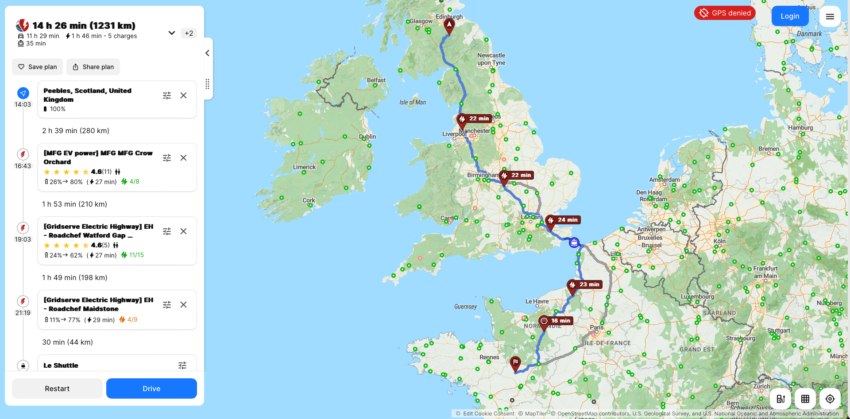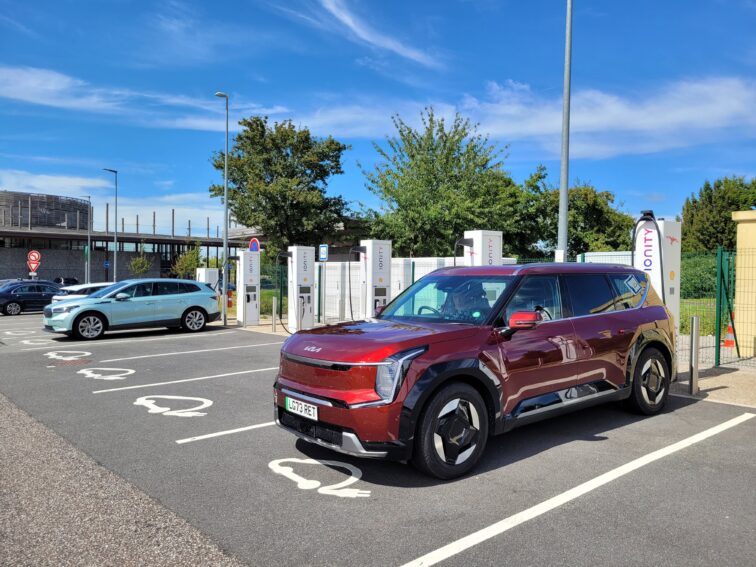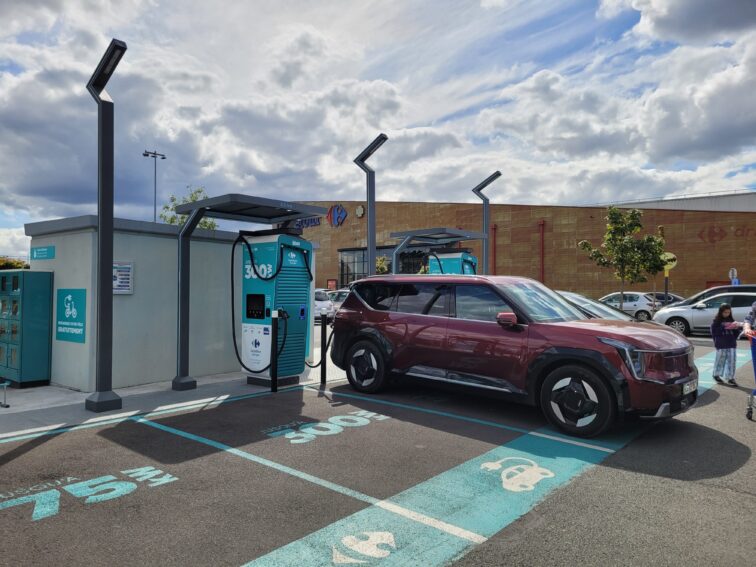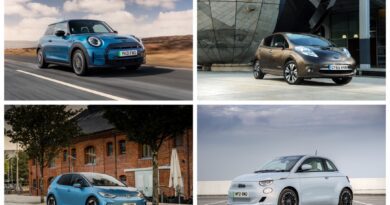
This is what I learned on an EV trip through France
With summer holidays here, we explain what’s involved in taking an electric car to Europe, from how to find chargers to how much it costs and how to pay
Planning a trip to Europe in an EV might sound like a major job, especially if you’re new to electric cars. It’s understandable that covering thousands of miles in another country where the charging landscape is unfamiliar might be a little daunting. But is it really that hard?
With France just a brief hop across the Channel, it’s the biggest European destination for holidaymakers driving to the Continent. And I’m no exception, so this year I figured I’d use our family getaway in the magnificent Kia EV9 to get the lowdown on driving an EV in France, from planning a route to finding and paying for chargers.
Here’s what I learned and some tips on how you can make an EV trip to Europe easy.
Proper planning prevents poor performance
As with any long-distance trip, planning is key to a painless EV experience.
Tesla drivers perhaps have it easiest. They can let their cars’ integrated mapping, charging and payment system do most of the heavy lifting unless they’re venturing far from the Supercharger network. For everyone else, you’ll want to spend a bit of time in advance thinking about your route, where you’ll stop and how you’ll pay for charging.
Unless your car uses native Android Automotive (like a Polestar or Renault) you’ll find its on-board route planner probably isn’t up to the task of plotting a long, multi-stop trip. Our EV9’s certainly wasn’t.
Thankfully there are EV-specific apps such as ABetterRoutePlanner (ABPR) which will plot your drive and tell you where you need to stop, for how long and even give a rough estimate of the cost. It also lets you choose waypoints, dictate start and finish charge levels, choose preferred charging providers and will take into account everything from your model to how much extra weight it’s carrying to inform its planning.
It’s not perfect – I found it overestimated our car’s energy use – but it does generally simplify the planning process and is compatible with Android Auto and Apple CarPlay (for a small fee). Alternatively, you can use the free version and plug its route recommendations into your mapping app of choice.

More generally, services such as Zapmap or Plugshare provide a countrywide overview of chargers and if you have a preferred network or provider its app will help pinpoint nearby charging locations.
One thing to bear in mind when planning is that packing your car full of luggage and people will affect your real-world range, as will Europe’s higher motorway speed limits. Our EV9’s efficiency fell from over 3m/kWh to 2.8m/kWh due to the added weight and higher speeds.
Have a back-up plan
Whatever the route, it’s worth noting alternative chargers near your intended stop and, just like at home, always allow a little energy reserve in case your first choice is busy or broken.
But don’t overthink things
Having said all that, it’s easy to overplan. I spent far more time than necessary exploring multiple route and charger options. The truth is that most of the time your first route will work out just fine and if traffic or charge levels throw a spanner in the works, you’ll be rerouting on the go anyway. In such cases hours staring at maps in advance is largely wasted and you’re better off making an on-the-go plan using one of the apps I’ve mentioned.
Charger provision
One reason that you don’t need to over-plan is that France’s public charging infrastructure is really well developed. While the UK is improving, France still feels a step ahead. Autoroutes feel far better supplied with new and ultra-fast chargers from a broader range of providers, including Ionity, Total, Fastned, Shell and Engie. Most service stations we stopped at had at least half a dozen units offer between 175kW and 350kW for ultra-quick and convenient charging en route.

Like in the UK, some sites can get busy at peak times but in my experience they’re quieter and quicker than in the UK, so you’ll never be waiting for long. Just double check what facilities are nearby. Most ultra-rapid sites are in busy motorway service areas but we found a couple in out-of-the-way areas with no shops or toilets.
Off major routes, the picture is more mixed but most larger towns offer at least a few 22kW or 50kW devices in central locations and some petrol stations have charging sites too. Some of these work with UK cross-network subscriptions such as Kia Charge but others require a membership to a local provider, so check before taking a detour.
Away from the motorway, I found supermarkets one of the best sources of charging, offering quick and convenient top-ups as I shopped. A huge number of Lidl stores have 120kW devices and major chain Carrefour provides everything from 22kW to 300kW at many of its larger stores. Even better, they use the same payment network as most of the manufacturer-provided packages, so your Kia Charge or Skoda Powerpass card will work just fine.
Paying for charging
As well as being plentiful, chargers in France are generally cheaper than in the UK. I used Ionity chargers a lot and its standard rate on the Continent is around 50p/kWh rather than 76p in the UK. Even the most expensive motorway devices were no more than 58p/kWh without a mobility subscription.
However, if you don’t already have a package such as Kia Charge, Mercedes Me Charge or VW’s We Charge, it’s well worth getting one. In my case, my £10.99 a month subscription cut costs to 35p/kWh in France.
A manufacturer-backed card like that or cross-network one such as Shell Recharge, Plugsurfing or Chargemap Pass also makes payment simple. Most cross-border networks accept them as do many single-country providers, and the contactless payment system is straightforward and reliable.

If you don’t have such a subscription, most ultra-rapid devices take contactless credit or debit card payment. However, some use payment pages linked to QR codes or apps and I spoke to a couple of drivers who struggled to get these working.
Other things to consider
Like the UK, some French cities, including Paris, Rouen, Lyon and Bordeaux enforce low-emissions zones. While your EV will be free to drive within them it must still display a Crit’air sticker confirming its emissions status. These cost €3.77 and must be ordered in advance (allow at least two weeks) from the official website.
Tolls. If you’re travelling long distances, France’s well-maintained and well-provisioned autoroutes are the way to do it but you pay for the convenience in the form of tolls. For me, that convenience is worth it, but the cost can add up, so factor it into your budget. Sites such as Tollguru can calculate the costs in advance.
Hassle-free holiday
In total, I covered more than 2,000 miles in France and the UK and my biggest takeaway was just how painless the whole process was.
Thanks to the wealth of well-placed and reliable chargers and apps to locate them, finding somewhere to recharge was stress-free. And because we were travelling with children we never wasted any time charging since we could tie in charging stops with the inevitable need to break for food or the toilet. Generally, the car was ready to go before we were.
Having a car with a big battery and ultra-quick charging definitely helps. With close to 300 miles real-world range and regularly charging at over 200kW, the EV9 allowed long drives and short stops where something smaller or slower might have led to some thumb-twiddling.
And having a cross-network subscription takes the stress and uncertainty out of paying. Even at our rural bolthole I was never far away from a device that would accept my card, and from start to finish the contactless system worked faultlessly. If you don’t already have such a subscription, it’s worth signing up for the duration of your trip.





